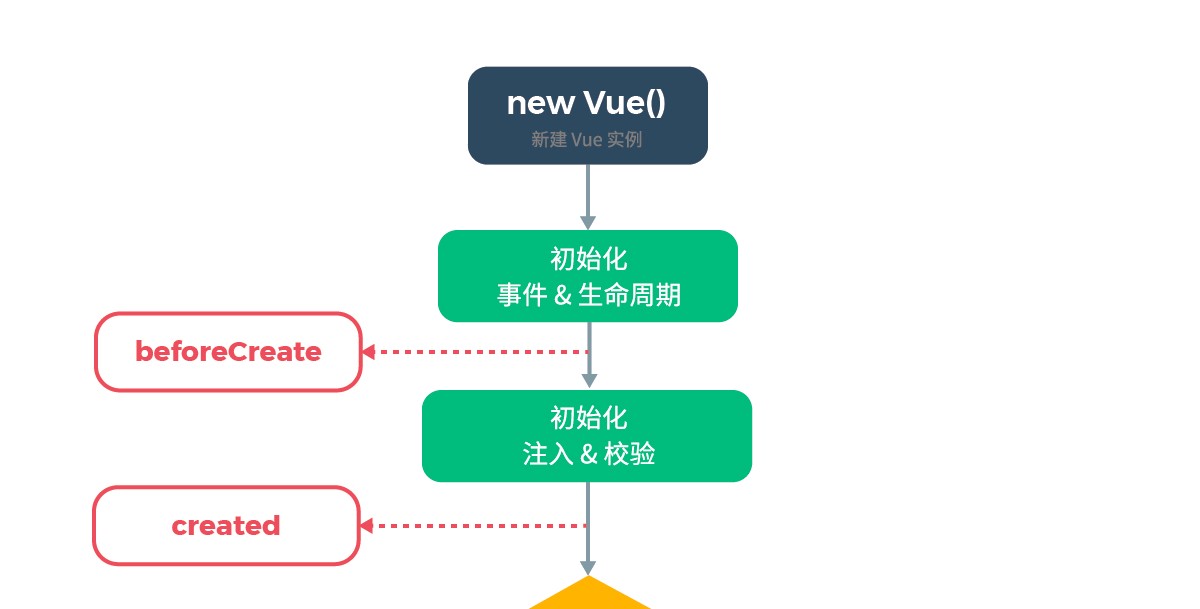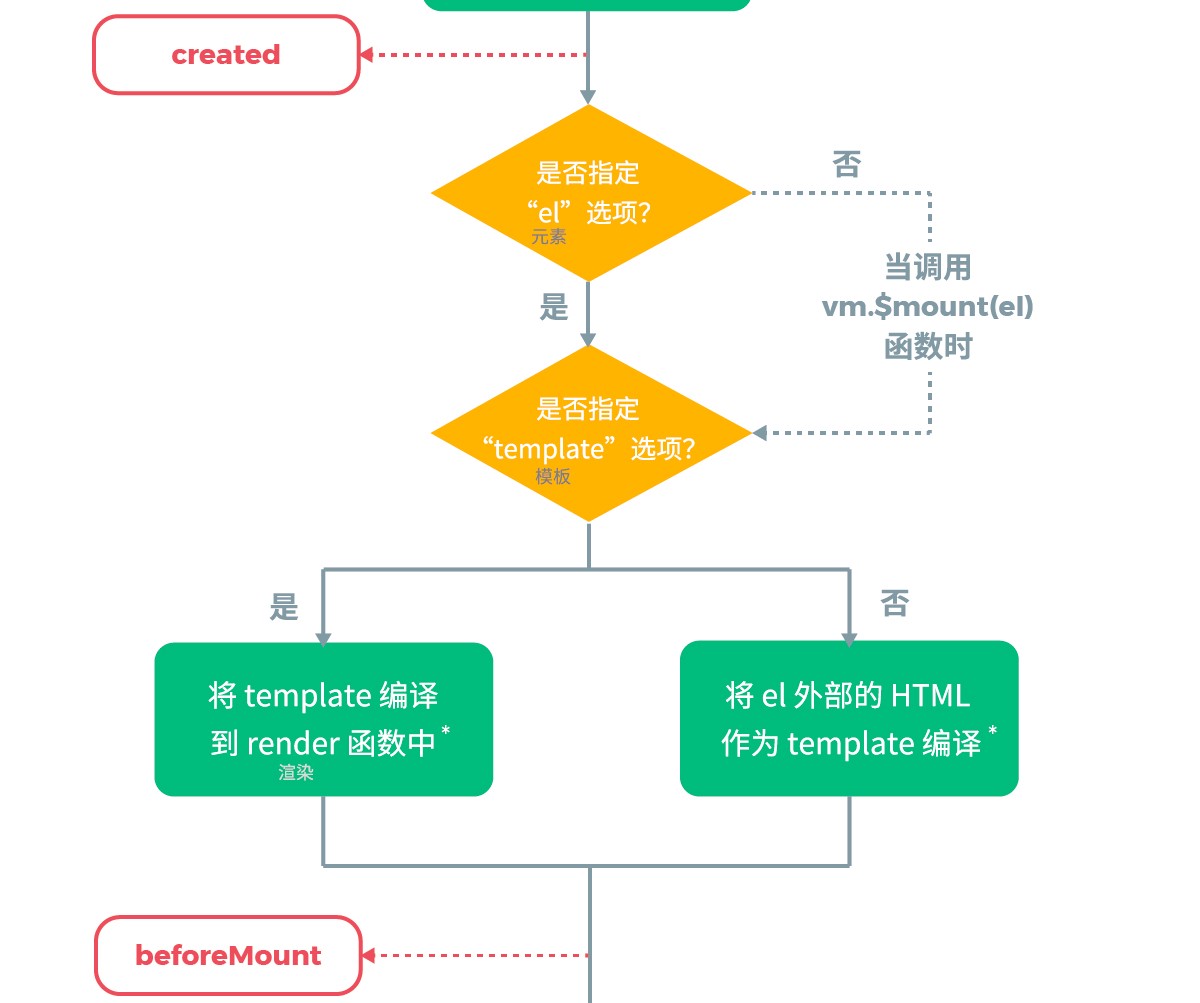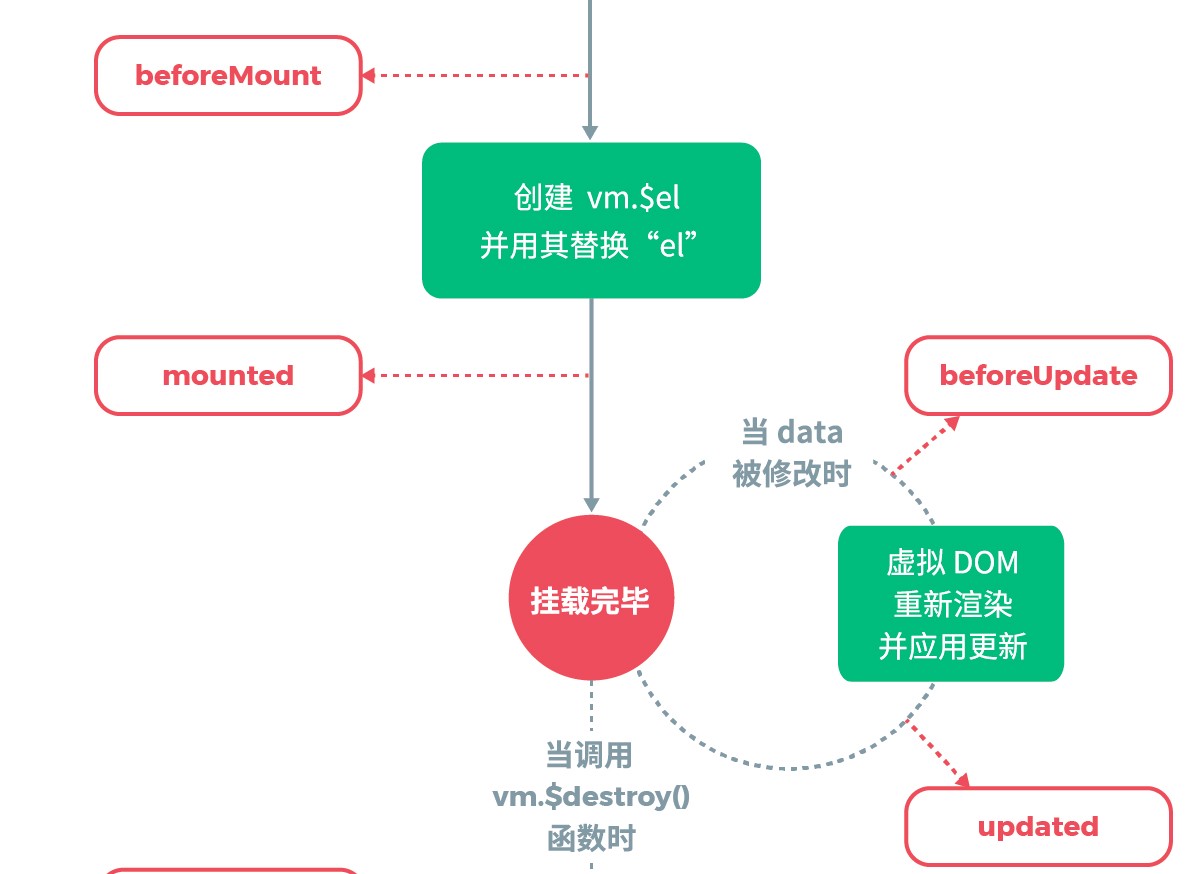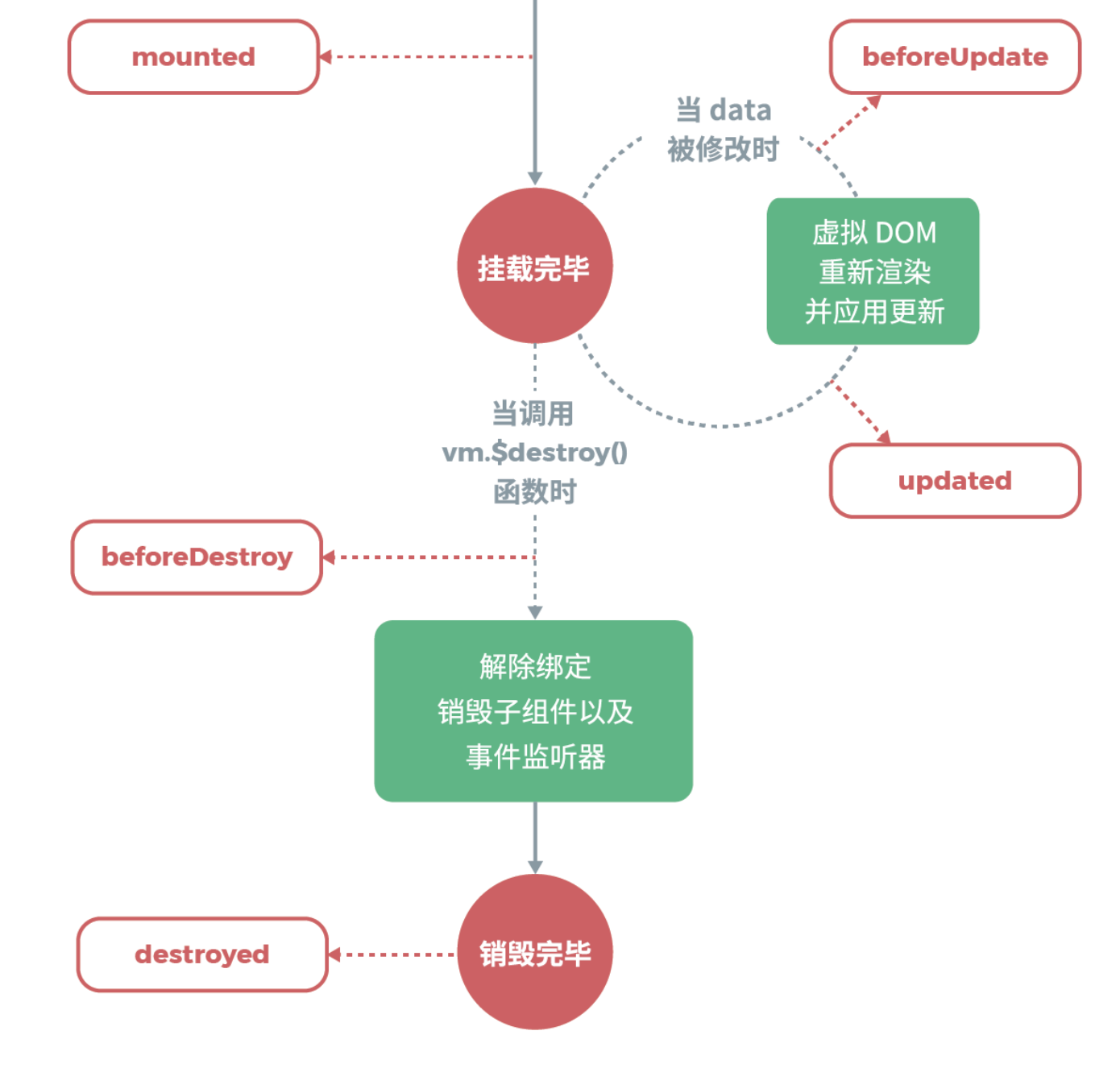
Vue 的生命週期
學 Vue 的時候,一定會接觸到的其中一個概念就是生命週期。
它讓我們在 Vue 實例創建到銷毀的過程中,
能獲取到每個階段的不同狀態,
讓我們來介紹一下生命週期吧!
以下分階段介紹 Vue 的生命週期:

(圖片擷取自 Vue 官網)
1. beforeCreate:
完成實例初始化,事件生命週期等。
2. created:
這時候 data, computed, methods, watch… 中的值都已被創建出來。
但 Vue 實例尚未掛載到 DOM 上。$el 也尚未被創建。
接著,

(圖片擷取自 Vue 官網)
這時候會檢查 el 是否存在,
如果 el 不存在的話,就必須手動執行 $mount() ,
才會繼續後續的 template 編譯。
因為 el 所表示的就是 Vue 創建後,所要掛載的位置。
如果要掛載的位置不存在的話,自然就沒有後續渲染出畫面的必要了。
再來會繼續判斷,是否有 template ?
- 如果有 template 的話,就會把 template 字符串轉為
render方法。 - 沒有的話,就會直接拿
el.outerHTML當成 template,一樣會轉為render方法。
但如果有 render 方法,就會跳過上面的內容。
也就是說,其實不論如何,最後都會執行 render()。
而這裡指的 render 方法 是什麼呢?
它的功用主要是拿來渲染出 VNode(虛擬 DOM)。

(圖片擷取自 Vue 官網)
3. beforeMount:
DOM 綁定之前,即將開始進行掛載。
4. Mounted:
完成創建 $el, 掛載 DOM 和渲染完成,
完成雙向綁定。
可以在 mounted 鉤子上進行對 DOM 的操作。

(圖片擷取自 Vue 官網)
5. beforeUpdate:
可以在更新之前,訪問現有的 DOM,
手動移除監聽器也是可能會在此使用的情境。
6. update:
完成 DOM 的渲染與更新。
可以操作 DOM 元素。
7. beforeDestory:
在此實體被銷毀前時叫用,這時實體還是擁有完整的功能。
8. destoryed:
實體銷毀。
所有綁定被解除、事件偵聽被移除。
掛載?
大致上說明完了。Vue 常使用到的生命週期。
每次看完之後,我都很好奇,
所謂的「掛載」到底是什麼?
能不能用文字試著去說明,於是深入了一點去了解,
從 new Vue 以來,到底發生了什麼事?
結論
先給結論好了。
所謂的掛載,我認為是將 VNode 渲染出來後,
並同步更新 DOM 完畢的這個過程。
也可以說,掛載完後,
Vue 的雙向綁定就算完成了。
來試著用 Vue 的原始碼來理解
Vue.prototype._init = function (options?: Object) {
const vm: Component = this
// a uid
vm._uid = uid++
let startTag, endTag
/* istanbul ignore if */
if (process.env.NODE_ENV !== 'production' && config.performance && mark) {
startTag = `vue-perf-start:${vm._uid}`
endTag = `vue-perf-end:${vm._uid}`
mark(startTag)
}
// a flag to avoid this being observed
vm._isVue = true
// merge options
if (options && options._isComponent) {
// optimize internal component instantiation
// since dynamic options merging is pretty slow, and none of the
// internal component options needs special treatment.
initInternalComponent(vm, options)
} else {
vm.$options = mergeOptions(
resolveConstructorOptions(vm.constructor),
options || {},
vm
)
}
/* istanbul ignore else */
if (process.env.NODE_ENV !== 'production') {
initProxy(vm)
} else {
vm._renderProxy = vm
}
// expose real self
vm._self = vm
initLifecycle(vm)
initEvents(vm)
initRender(vm)
callHook(vm, 'beforeCreate')
initInjections(vm) // resolve injections before data/props
initState(vm)
initProvide(vm) // resolve provide after data/props
callHook(vm, 'created')
/* istanbul ignore if */
if (process.env.NODE_ENV !== 'production' && config.performance && mark) {
vm._name = formatComponentName(vm, false)
mark(endTag)
measure(`vue ${vm._name} init`, startTag, endTag)
}
if (vm.$options.el) {
vm.$mount(vm.$options.el)
}
}下面是 Vue 在初始化時的原碼,
一開始就會先初始化生命週期、data、props、component、watcher 等。
可以發現,
在 beforeCreate 前,初始化的是事件、生命週期、Render 函數。
在 created 前,初始化的是 data, computed, prop, methods 等。(initState(vm) 中)
完全如同上面圖片所示。
這也是為什麼我們在 created 之後,才可以取得 data 中的值。
接著如果 vm.$options.el 存在的話,就會執行 $mount()
而相關程式碼如下:
const mount = Vue.prototype.$mount
Vue.prototype.$mount = function (
el?: string | Element,
hydrating?: boolean
): Component {
el = el && query(el)
/* istanbul ignore if */
if (el === document.body || el === document.documentElement) {
process.env.NODE_ENV !== 'production' && warn(
`Do not mount Vue to <html> or <body> - mount to normal elements instead.`
)
return this
}
const options = this.$options
// resolve template/el and convert to render function
if (!options.render) {
let template = options.template
if (template) {
if (typeof template === 'string') {
if (template.charAt(0) === '#') {
template = idToTemplate(template)
/* istanbul ignore if */
if (process.env.NODE_ENV !== 'production' && !template) {
warn(
`Template element not found or is empty: ${options.template}`,
this
)
}
}
} else if (template.nodeType) {
template = template.innerHTML
} else {
if (process.env.NODE_ENV !== 'production') {
warn('invalid template option:' + template, this)
}
return this
}
} else if (el) {
template = getOuterHTML(el)
}
if (template) {
/* istanbul ignore if */
if (process.env.NODE_ENV !== 'production' && config.performance && mark) {
mark('compile')
}
const { render, staticRenderFns } = compileToFunctions(template, {
shouldDecodeNewlines,
shouldDecodeNewlinesForHref,
delimiters: options.delimiters,
comments: options.comments
}, this)
options.render = render
options.staticRenderFns = staticRenderFns
/* istanbul ignore if */
if (process.env.NODE_ENV !== 'production' && config.performance && mark) {
mark('compile end')
measure(`vue ${this._name} compile`, 'compile', 'compile end')
}
}
}
return mount.call(this, el, hydrating)
} 先把原本的 $mount 存進變數裡,
然後寫了一個新的 function 覆蓋 $mount
而這新的 function 主要就是先判斷了是否存在 render 方法,
若不存在則判斷是否有 template,
若有的話,會透過 compileToFunctions 將 template 轉為 render 方法,
最後再存進 options 裡。
最後在執行一次 mount(前面先預存的原本的 $mount)
所以 $mount 又做了啥呢?
export function mountComponent (
vm: Component,
el: ?Element,
hydrating?: boolean
): Component {
vm.$el = el
if (!vm.$options.render) {
vm.$options.render = createEmptyVNode
if (process.env.NODE_ENV !== 'production') {
/* istanbul ignore if */
if ((vm.$options.template && vm.$options.template.charAt(0) !== '#') ||
vm.$options.el || el) {
warn(
'You are using the runtime-only build of Vue where the template ' +
'compiler is not available. Either pre-compile the templates into ' +
'render functions, or use the compiler-included build.',
vm
)
} else {
warn(
'Failed to mount component: template or render function not defined.',
vm
)
}
}
}
callHook(vm, 'beforeMount')
let updateComponent
/* istanbul ignore if */
if (process.env.NODE_ENV !== 'production' && config.performance && mark) {
updateComponent = () => {
const name = vm._name
const id = vm._uid
const startTag = `vue-perf-start:${id}`
const endTag = `vue-perf-end:${id}`
mark(startTag)
const vnode = vm._render()
mark(endTag)
measure(`vue ${name} render`, startTag, endTag)
mark(startTag)
vm._update(vnode, hydrating)
mark(endTag)
measure(`vue ${name} patch`, startTag, endTag)
}
} else {
updateComponent = () => {
vm._update(vm._render(), hydrating)
}
}
// we set this to vm._watcher inside the watcher's constructor
// since the watcher's initial patch may call $forceUpdate (e.g. inside child
// component's mounted hook), which relies on vm._watcher being already defined
new Watcher(vm, updateComponent, noop, {
before () {
if (vm._isMounted) {
callHook(vm, 'beforeUpdate')
}
}
}, true /* isRenderWatcher */)
hydrating = false
// manually mounted instance, call mounted on self
// mounted is called for render-created child components in its inserted hook
if (vm.$vnode == null) {
vm._isMounted = true
callHook(vm, 'mounted')
}
return vm
}有兩個比較關鍵的地方為
updateComponent = () => {
vm._update(vm._render(), hydrating)
}
new Watcher(vm, updateComponent, noop, {
before () {
if (vm._isMounted) {
callHook(vm, 'beforeUpdate')
}
}
}, true /* isRenderWatcher */)我們可以理解為,在 mounted 之前,
Vue 創建了一個 Watcher 去監聽 Vue 實例數據的變化(第一個帶入的參數 vm)。
監測到變化後,會執行 updateComponent。
updateComponent 這個 function
會透過 vm._render() 生成虛擬 DOM,
然後 update() 才更新真實 DOM。
我自己理解為:render() 所做的是,生成相對應的 VNodeupdate() 所做的是把 VNode 渲染成真实的 DOM
最後就會執行 mounted。
說到這邊,其實還是有很多沒說明完的。
例如:vm._render() 實際上到底做了什麼?是怎樣生成 VNode…等。
但我想至少對於整個 Vue 的運作過程,
有了更深一層的理解。
看見了在 beforeCreate 時,做了哪些事。
發現了在 created 才能訪問 data 的直接證據。
好像理解了所謂 ” 掛載 “ 的意思。(至少可以自己用中文說出來)
參考資料:
https://ustbhuangyi.github.io/vue-analysis/v2/data-driven/new-vue.html
https://ustbhuangyi.github.io/vue-analysis/v2/data-driven/mounted.html
https://segmentfault.com/a/1190000014640577
 標籤雲
標籤雲 文章列表
文章列表